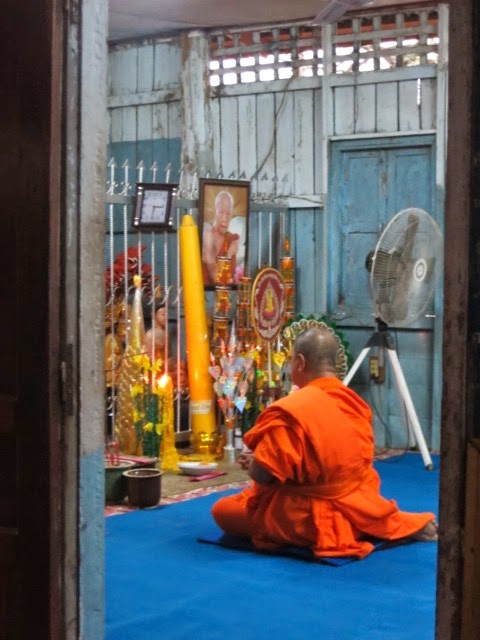| Richard Parker also visited Lao PDR. |
| morning market |
In the middle of the 16th century, King Saya Setthathirat transferred the capital from Luang Prabang to Vientiane and the Kingdom flourished, but the eighteenth century brought the decline of the monarchy. The Kingdom split into three hostile dynasties and was invaded and controlled by Siam (Thailand).
The town of Luang Prabang is built on a peninsula formed by the
Mekong and the Nam Khan Rivers.
|
In the late 1880s and early 1890s French influence in the area grew. Then, in 1893, the Siamese formally surrendered all territory east of the Mekong to the French and the French protectorate of Laos was created, uniting the three independent kingdoms. Eventually, however, the French lost control of Southeast Asia and in 1953, they withdrew from Laos.
However, Laos in the 1950s was still a divided country. The Communist and North Vietnam-allied, Pathet Lao struggled to overthrow the French-leaning monarchy. Attempts to find a political solution failed and in the 1960s Laos became drawn into the wider Asian War.
| Laos is officially Buddhist |
During the Vietnam War (1964-1973) the United States dropped almost 2 million tonnes of bombs on Laos, mostly in the northeast. In 1975, after the fall of Saigon, the Communist Pathet Lao party took control of Vientiane and ended a six-century-old monarchy. The Lao People’s Democratic Republic was founded.
In 1986, the Lao PDR began to carry out a comprehensive renovation policy, shifting from a centralized economy to a market-oriented economy. Initial closer ties to Vietnam and socialization were replaced with a gradual return to private enterprise, an easing of foreign investment laws, and admission into ASEAN in 1997.
Since 1997, the government has made a concerted effort to attract tourists to the country and tourism has become the biggest growth sector in Laos.
Many Lao families send one or more sons to the Buddhist temples in order for them to receive a good education - something that the family cannot afford. Luang Prabang is home to many monks, some as young as 8 or 9.
Alms Giving (tak bat, left). Silent lines of saffron-clad monks walk down the streets of Luang Prabang in the early morning to collect food. The local people wait for them on mats or small plastic chairs, sometimes kneeling, and place food (most often sticky rice), flowers or incense sticks in the bowls. There are almost 80 temples in Luang Prabang, so the practise sustains large monastic communities. Monks take different routes depending on where in town their temple stands.
Luang Prabang is the former capital of Laos and is a UNESCO World Heritage city. The town is built on a peninsula formed by the Mekong and the Nam Khan Rivers. Mountain ranges surround the city. French influence in the 1800’s led to the construction of the many fine colonial villas that today can be seen alongside the traditional Lao architecture.
 |
The town is famous for its unique textiles and beautiful mulberry paper. Along one street in Luang Prabang, several artists were displaying their work. They paint on posa paper made from mulberry bark, which has long been used in Laos.
| Rows of paintings lined one street near the river. |
Many traditional Lao houses remain; they are built of wood using traditional techniques and materials introduced in the colonial period, such as plaited bamboo panels coated with wattle and daub. Brick colonial buildings, often with balconies and other decorative features in wood, line the main street and the Mekong.
| Luang Prabang is a beautiful city, but has its share people struggling to make a living. |
At right, shoes outside a temple at the site of the Royal Palace.
The city owes its present name to the Pha Bang, a revered Buddha image (now in the Royal Palace Museum) which was brought to the city by King Visoun during the golden age of Lan Xang in the early 1500s.
Wat Manorom is well away from the normal tourist route and it still has a large population of resident monks.
|
| Wat Manorom |
There are a little more than 30 temples in the relatively small town of Luang Prabang. The monastic community of Wat Manorom (right) has the largest number of monks and novices of any monastery in Luang Prabang and also has a primary school. This is possibly the oldest temple site in Luang Prabang.
I thought these garbage bins, found throughout Luang Prabang, were
much more aesthetically pleasing than the big plastic ones found in
most North American cities.
|
| We crossed this bridge, over the Nam Khan River where it meets the Mekong, to visit the village of Ban Xang Khong. |
In the village, we watched traditional silk making and weaving.
|
| More shoes line the stairs at Wat Xieng Thong. |
 |
| Door carving |
The girls, above, were selling paintings and jewellery in a field by the Nam Khan River.
| Naga at Wat entrance. |
Naga are believed to live in the Laotian stretch of the Mekong river or estuaries. Lao mythology maintains that the Naga are the protectors of Vientiane, and by extension, the Lao state.
| Luang Prabang is home to many 'hidden' shrines, like the one above. |
 |
| There is a Buddhist shrine for every day of the week on Mt. Phousi. |
Mount Phou Si is a 100m high hill in the centre of the old town of Luang Prabang. The hill is a local religious site, and houses several Buddhist shrines, like the one at left. To get the top, visitors must climb 355 steps, but the panoramic view of the city at the summit is worth the climb.
| Even monks have laundry! |


